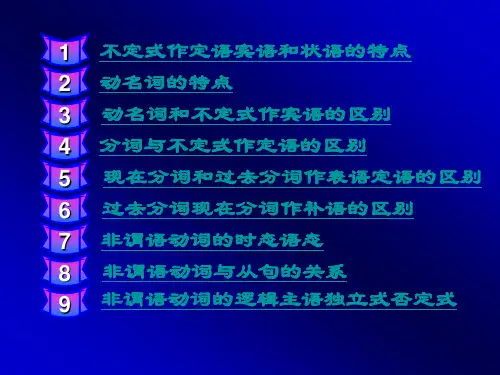seeing is believing.眼见为实。
固定搭配
cannot / hardly / never / scarcely too …to…
“越……越好;无论……也/都不过分”。
You cannot be too careful to cross the street. 你过街时越小心越好。 can’t (help/choose) but 不得不,只能,不禁 I cannot help but tell her the truth. 我只能告
动词不定式; 现在分词; 过去分词; 动名词
1.不定式的时态及语态
一般式 to do to be done 与谓语动作同时
进行式 to be doing
表示谓语的动作
发生时,不定式的动作正在进行
完成式 to have done to have been done 先于谓语动作的发生
用途: 表将来 表某一次具体的动作 表目的
*考点三 why not do sth (为何不做某事)
考点四:非谓语动词作主语时,注意:
1、不定式和动名词可以在句中当主词,但分词 不行。
2、不定式一般表示具体或一次性动作,而动名 词则表示一般或抽象的多次动作。
___should not life and work.(2010.51)
考点二“使……怎么样”之类的动词
amuse, astonish, excite, frighten, interest, move,
relax, satisfy, shock, surprise, encourage, disappoint, puzzle, tire, please, inspire, terrify, worry,它们的ing 形式表示主动,而过去分词表示被动。一般情况下 “人”用过去分词,“物”用ing形式。










